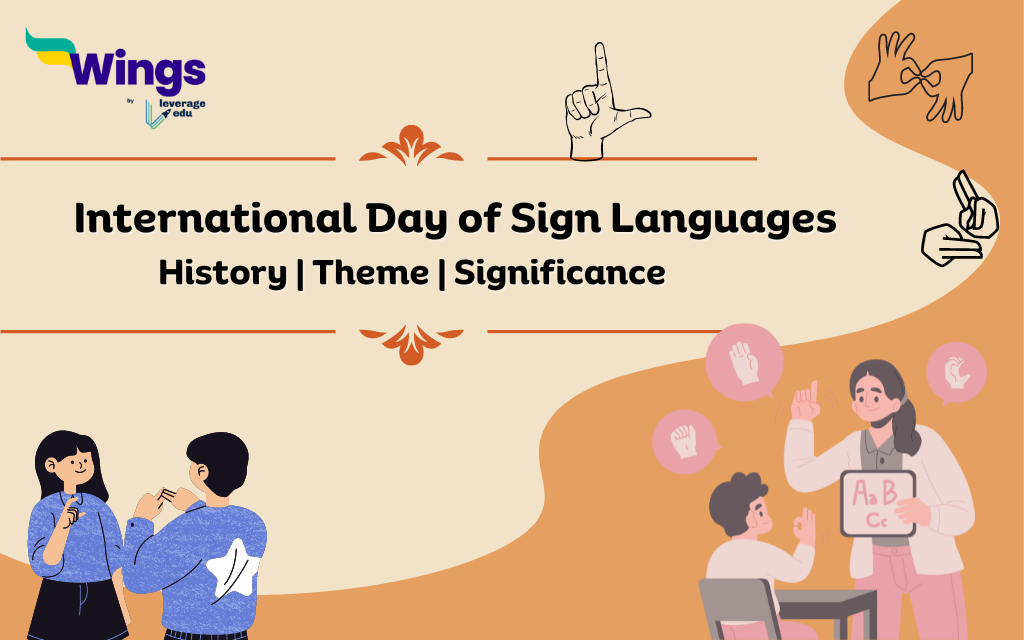International Day of Sign Languages is celebrated every year on September 23. It highlights the importance of sign language in ensuring inclusivity across the globe. Millions of deaf people use sign language around the world as their primary mode of communication. The objective of organising the International Day of Sign Languages is to raise awareness of the importance of sign languages and to promote the rights of deaf people. Also, this day tends to highlight the cultural and linguistic diversity of deaf communities around the world. In this article, we will tell you all about the International Day of Sign Languages.
| Event | International Day of Sign Languages |
| Organising Body | United Nations General Assembly |
| Observed on | 23rd September |
| Started in | 2018 |
| Objective | Raise awareness about the importance of sign language. Promote the rights of deaf people. |
| Theme | Sign Up for Sign Language Rights |
Contents
History
On 19th December 2017, a proposal was made by the World Federation of the Deaf, which was signed by 135 national associations of Deaf people and communities. All the associations represented approx. 70 million deaf people The Permanent Mission of Antigua and Barbuda to the United Nations, sponsored the resolution for the formation of the International Day of Sign Languages. Later on, it was co-sponsored by 97 United Nations Member States.
What is the Theme of the International Day of Sign Languages in 2024?
The theme of International Day of Sign Languages in 2024 is, “Sign up for Sign Language Rights.” It encourages individuals and organisations around the world to adopt and encourage the use of sign language. In this way, every small step can lead towards a more inclusive and bright future for deaf communities.
Also Read: Best Foreign Language Jobs for Language Enthusiasts
Importance of the International Day of Sign Languages
This not-so-popular day brings out an important question; what is the importance of the International Day of Sign Languages? Well, for people who work in government and NGOs for the welfare of the deaf and persons with disabilities, they simply put it this day: Raising awareness about the importance of sign language and the inclusion of deaf people and their communities into our society.
The records of the Word Federation of the Deaf estimate that more than 70 million people in the world are deaf and many more have hearing disabilities. Out of these 70 million, more than 80% belong to developing nations. Presently, deaf people and communities around the world use more than 300 sign languages. In 2018, the first International Day of Sign Languages was celebrated as part of the International Week of the Deaf.
Now you might be wondering do I have to learn sign languages to communicate with deaf people? Well, the answer is yes. That’s the only way you can communicate with a person who is having hearing loss or disorder.
This year’s theme for the International Day of Sign Languages is ‘A World Where Deaf People Everywhere Can Sign Anywhere.’ Don’t know what it means? It says that the world needs to highlight unity using sign languages. All the organizations out there are putting their collective efforts to foster, promote and recognise their own national sign languages.
How to Celebrate International Day of Sign Languages?
- Encourage your friends and family to learn basic sign language gestures to improve communication with the deaf community.
- Participate in events hosted by the deaf community like exhibitions and seminars.
- Spread awareness on social media through articles, videos, and posts about the importance of sign language.
- Donate to charities and NGOs.
- Volunteer at NGOs working to support deaf people.
Also Read: Scholarships for Students with Disabilities
What are Sign Languages?
Sign languages are fully developed languages and have their own vocabulary and grammar. Deaf people and their communities use sign language to communicate with each other. The goal of the International Day of Sign Languages is to recognize sign languages because these languages ensure that deaf people and their communities are part of our society.
The UN General Assembly and other governmental and private organizations annually organise events, activities and conferences related to deaf advocacy and education on this day. All the events are focused on promoting the use of sign languages, to raise awareness about the rights of deaf people and to foster an understanding and inclusion of their communities.
Some of the features of sign languages are listed below:
- Sign languages often involve manual signs, such as handshapes, movements and orientation that convey meaning.
- Using facial expressions is an important part of sign language. For example: a person raising their eyebrows means they have a question.
- Sign languages have their own grammatical and vocabulary rules.
- Variations in regional sign languages are just like spoken languages.
Sign languages are not universal. There are several sign languages used all over the world, all of them having their own variations and features. For example: The British Sign Language, the American Sign Language, etc.
Related Blogs
| World Peace And Understanding Day | World Kindness Day |
| Prevention of Blindness Week | World Hearing Day |
| World Health Day Speech | World Health Day |
FAQs
A. The International Day of Sign Languages is annually observed on 23rd September along with the International Week of the Deaf.
A. The theme for this year’s International Day of Sign Languages is ‘A world where deaf people everywhere can sign anywhere.’
A. There are various sign languages, some of which are manual signs, facial expressions, grammar and vocabulary, regional languages, etc.
For more information about such topics, visit our important days page and make sure to follow Leverage Edu.
 One app for all your study abroad needs
One app for all your study abroad needs














